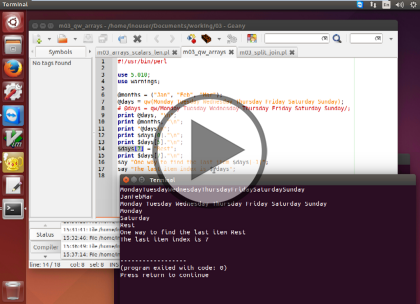Course description
In this course, Perl expert Chris Penick explains how Perl makes it easy to store single or multiple items of data using lists and arrays. Penick will also show how arrays can be easily manipulated and teach you about using scalars. This course will also discuss other common computing elements and list assignments as well as how to make your Perl scripts as flexible as possible.
Prerequisites
This is an entry level course. Some amount of programming experience will be helpful and speed up your learning but you can jump right into this course at any level.
Learning Paths
This course is part of the following LearnNowOnline SuccessPaths™:
PERL Development
Meet the expert
Chris Penick is CISSP certified and has been a consultant and CISSP trainer in the technology industry for the past 20 years. During that time, he has worked as Principal Learning Consultant for Symantec, webmaster for the FDA, cyber-warfare scenario developer, technical investigator and forensic analyst for a private security firm. His past government clients include all branches of the United States Military, the Department of Commerce, the IRS, the U.S. Custom and Immigration Service, the Executive Office of the President, and state and local governments in Maryland, Michigan, Virginia, and the District of Columbia. His corporate clients include Guess, Inc., EMC, Raytheon, Lockheed Martin, and the Discovery Channel.
Course outline
Data Structures, Input and Output
Lists (19:11)
- Introduction (00:17)
- Lists (00:58)
- List Element Access (01:20)
- Computing Elements (01:14)
- Maximum Element (01:25)
- Going out of Bounds (00:46)
- List Literals (01:33)
- List Assignment (01:41)
- Arrays (01:23)
- Find the Last (01:12)
- Array Interpolation (02:17)
- Sorting Arrays (01:29)
- Manipulating Arrays & Strings (00:12)
- Strings to Arrays: Split (01:11)
- Split on Any Character (00:23)
- Split on Multiple White Space (00:53)
- Join (00:37)
- Summary (00:14)
List Demos (18:19)
- Introduction (00:17)
- Adding or Removing Items (01:18)
- Demo: Add or Remove Items (05:12)
- Demo: Arrays and Scalars (04:09)
- Demo: Interpolating Arrays (03:50)
- Demo: Split and Join (03:14)
- Summary (00:17)
Command Line Input (16:54)
- Introduction (00:18)
- Simple Input (01:58)
- Chomp (00:24)
- Chop (00:33)
- Simple Output (01:48)
- Command Line Arguments (01:26)
- Demo: Input and Output (06:13)
- Demo: Command Line (03:55)
- Summary (00:16)
File Input & Output (17:27)
- Introduction (00:16)
- Handling Files (02:21)
- Handling Files, Cont. (02:20)
- File Test Operators (01:12)
- Demo: Working with Files (05:02)
- Demo: Diamond and File Checks (06:00)
- Summary (00:13)
Hashing (17:51)
- Introduction (00:22)
- Hashes (01:25)
- Adding a New Key-Value Pair (00:46)
- Changing the Value of a Key (01:33)
- Hashes and Foreach (00:48)
- Hashes and Sorting (00:19)
- Demo: Create Hash (05:45)
- Demo: Hash Sort Check (02:11)
- Demo: Hash with Foreach (04:25)
- Summary (00:13)



